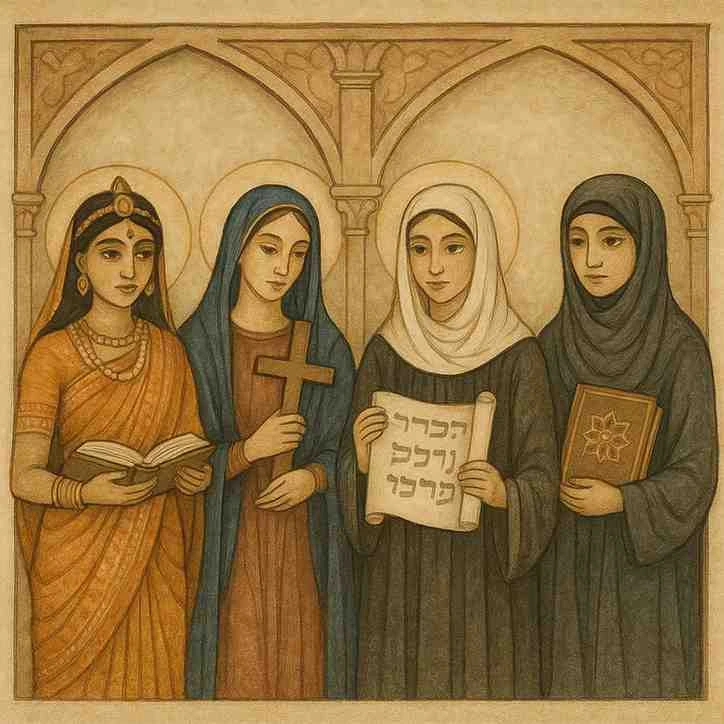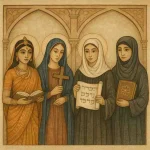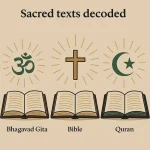Women in Scriptures — Myth or Message?
Sacred texts across the world hold within them powerful stories—stories that shape civilizations, influence moral values, and guide cultural norms. Among the many recurring themes, the portrayal of women in scriptures remains one of the most debated. Are these depictions symbolic myths meant to teach lessons, or are they historical narratives carrying deeper messages? Exploring this question reveals that women in religious texts are far more than supporting figures. They often represent strength, wisdom, sacrifice, and spiritual insight, offering timeless guidance even in modern society.
1. Women as Symbols of Strength
Across many scriptures, women are often depicted as embodiments of extraordinary strength. In Hindu traditions, goddesses like Durga, Lakshmi, and Saraswati symbolize power, prosperity, and knowledge. These portrayals are not mere mythology; they reflect a philosophical message—that the feminine energy (Shakti) is essential for cosmic balance.
Similarly, the Bible presents strong women like Esther, who courageously saves her people, or Mary, whose faith becomes central to Christian belief. These figures serve as symbols of resilience, reminding readers that strength often reveals itself through quiet determination rather than physical power.
In the Quran, women like Maryam (Mary) are highlighted for their devotion, character, and purity. The Quran’s emphasis on her spiritual rank offers a message that women are equally capable of deep, unwavering faith.
2. Women as Keepers of Wisdom
Many scriptures present women as carriers of profound wisdom. In the Bhagavad Gita and other Hindu texts, wisdom is frequently associated with the feminine principle. Stories of Gargi, Maitreyi, and other female sages demonstrate intellectual equality and spiritual understanding.
In the Bible, the Book of Proverbs personifies wisdom itself as a woman—“Lady Wisdom.” This poetic imagery conveys the message that truth, insight, and moral clarity carry a feminine essence.
The Quran includes narratives where women make pivotal decisions, such as the Queen of Sheba (Bilqis), who chooses peace over conflict. Her reasoned leadership illustrates that wisdom transcends gender and that women have historically shaped societies through intellect and diplomacy.
3. Women as bearers of sacrifice and compassion
Scriptures consistently depict women as figures of deep compassion and sacrifice. Sita in the Ramayana endures hardships that symbolize purity, dedication, and emotional strength. Though often debated for her trials, her story conveys a message about the resilience of truth and dignity.
The Bible emphasizes compassion through figures like Ruth, who stays devoted to her family despite personal loss. Her loyalty becomes a model of love and humanity.
In Islamic tradition, Hajar (Hagar) shows extraordinary perseverance in the desert, a story commemorated each year during the pilgrimage (Hajj). Her sacrifice becomes a living spiritual lesson about trust and courage amid adversity.
These narratives, even when mythic in structure, highlight the emotional and moral leadership women offer—a message that remains relevant beyond religious boundaries.
4. Myths, Metaphors, and Deeper Meanings
Many stories involving women in scriptures are metaphorical, representing broader philosophical principles. For example:
Hindu mythology often uses divine feminine figures to symbolize universal forces like knowledge, time, or creative energy.
In the Bible, many parables and metaphors use female characters to illustrate spiritual themes such as forgiveness or redemption.
The Quran uses the lives of certain women to demonstrate moral lessons on patience, justice, and faith.
Thus, even if some stories appear mythical, their underlying messages carry ethical and spiritual importance. Myths, in this sense, are not false stories—they are symbolic narratives meant to convey truths that logic alone cannot express.
5. Misinterpretations and Cultural Filters
A significant challenge is that many interpretations of scriptures have been shaped through patriarchal lenses. Over centuries, cultural practices sometimes overshadowed the original messages, leading to restrictions on women’s roles that the original texts did not always intend.
For example:
Some Hindu traditions elevated goddesses while restricting real women’s freedoms—an irony stemming from social norms, not scripture.
Biblical verses, when taken out of context, have been used to justify inequality, despite Christianity’s core message of universal love and dignity.
Misreadings of Quranic passages have sometimes overshadowed the text’s emphasis on respect, justice, and equity for women.
Re-examining scriptures with balanced understanding helps separate cultural bias from spiritual intent.
6. Messages for the Modern World
What, then, do these ancient portrayals teach us today?
First, they reveal that women have always been integral to spiritual narratives—not secondary characters, but central forces. Their stories remind us of:
the power of resilience
the wisdom born from intuition
the importance of moral courage
the need for compassion in leadership
Second, these portrayals challenge modern societies to rethink stereotypes. When sacred texts show women as leaders, philosophers, warriors, and saints, it becomes clear that gender equality is not a modern invention—it is rooted in ancient wisdom.
Beyond Myth Lies Meaning
Women in scriptures occupy a unique dual position—they are both mythic and profoundly real. Whether depicted as goddesses, queens, mothers, or disciples, their stories communicate powerful messages about human potential, spiritual depth, and the balance of creation.
The question is not whether these portrayals are myth or history. The real question is:
What are they trying to teach us?
Across traditions, the answer remains the same—women are carriers of strength, guidance, compassion, and divine insight. Their presence in scripture is not incidental; it is essential.
~Religion World Bureau









